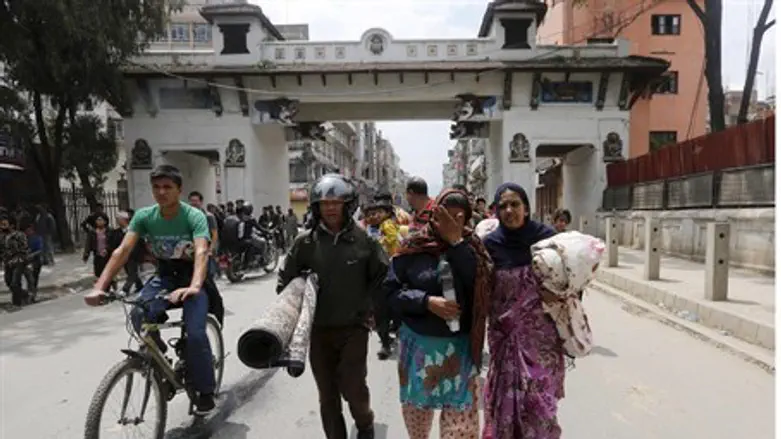
The American Jewish Joint Distribution Committee (a.k.a. the Joint or JDC) is one of the largest charities in the world. It has operations in 80 countries around the world and has responded to disasters everywhere.
“In places where JDC has a presence, we take the lead,” says Michael Geller, spokesperson for JDC in New York.
"In Nepal, until today we didn't have a presence on the ground," says Geller. "Within the first 24 hours of the crisis we connected with our partners - Tevel b'Tzedek - an Israeli NGO based in Nepal; UNICEF, with whom we worked in Haiti; and the IDF field hospital with whom we worked in Haiti, Sri Lanka, Japan, and the Philippines. So far, we have sent neonatal incubators and other equipment to the field hospital in Nepal.”
Geller emphasizes that the most important things at the beginning of the crisis food, drinkable water and medical care. When asked if he could confirm reports that lack of clean water was proving to be a major issue, he confirmed as such.
"Water is a massive problem, but from the reports from our team on the ground, electricity in Kathmandu is also a problem. There is also no easy access for money from banks. The devastation in rural towns is very absolutely harrowing."
This is the first time Nepal has experienced an earthquake literally of this magnitude in 80 years. Nepal's current infrastructure was evidently not prepared for such a seismic shift in the country.
"It is a humanitarian crisis that at the very least the Nepalese haven't seen in a very long time."
At the moment, the JDC only has two individuals on the ground, with more trickling in over the next few days. When asked why the number was so small, Geller emphasized it is a matter of allowing the most essential personnel to come in first.
"Mike Attison is a disaster relief expert, emergency medic, and veteran of JDC disaster response interventions in places like the Philippines. Elijah Jacob is the JDC India Country director, lead on JDC's Indian Ocean Tsunami response in India, and an Indian Jewish leader."
"We work by staggering. In any sort of disaster situation and particularly one at this level you want to be sure not to rush large teams of people in. The IDF is a massive operation doing absolutely miraculous work - they are a different case."
Geller explains that you do not want to strain limited local resources to accommodate too many rescuers, in an odd catch-22 of a situation. While a large amount of supplies would sustain that effort, the new supplies should primarily be for the people who most immediately need it, particularly people who will not have had time to rest or eat ahead of the trip and may have just reached help stations.
"You do have exceptions, and those exceptions are very well-trained people who know how to work in that system."
This might be another explanation why the Israeli government is so eager to get Israelis who were in Nepal at the time of the earthquake out of the country as soon as possible, in addition to the reports of rioting in the country. While the volunteering is welcome, the number of volunteers has to be sustainable.
"We operate on three fronts," says Geller. "One, we support our partners in the country. Two, we deploy our disaster relief system. Three, we ship in humanitarian and medical supplies with our partner the AFYA Foundation in conjunction with the Nepalese Consulate in New York City to expedite shipping.
The JDC is well known also for investing in long-term sustainability projects like the ones it is just now wrapping up in Haiti. However, it is not exactly clear just yet what the rebuilding process will entail in Nepal as opposed to in Haiti.
"They will engage in aid distribution, coordinate different partners with the IDF field hospital and they communicate back to the JDC; then of course they have to keep an eye on mid-to-long-term recovery. There are areas where we focused on recovery but it is still too early to tell what that recover will look like. This is an earthquake that has impacted 8 million people, injured thousands and killed over 5,000 people that we know of."
"Our focus is self-sustainability. We want to know that when we set up a project -whether emergency management, building schools, restoring livelihoods - we want to ensure those projects will continue on."
"We do know that the main area of recovery to focus on is ongoing medical care and medical services, educational outlets, restoration of livelihood like microloans for businesses or materials needed for livelihood.”
He cites examples like fishing boat supplies given to Filipino fishermen in the past. But the conceptual training is critical for the future. After such a massive disaster, a country is more open to preparing for such a massive event again, knowing how dire things were when things were not in place.
“We do disaster mitigation training to take care of themselves and families, we train municipalities, and we train volunteers to ensure early warning systems are in place and items essential to livelihood are secured.”
In Haiti, the JDC is actually leaving control of its projects to local organizations, such as a system of schools it helped to start after the earthquake there in 2010. The JDC is already considering what will be the need in the future. However, JDC is definitely involved right now in the response, and is requesting donations.
You can donate to the JDC effort in Nepal here.
